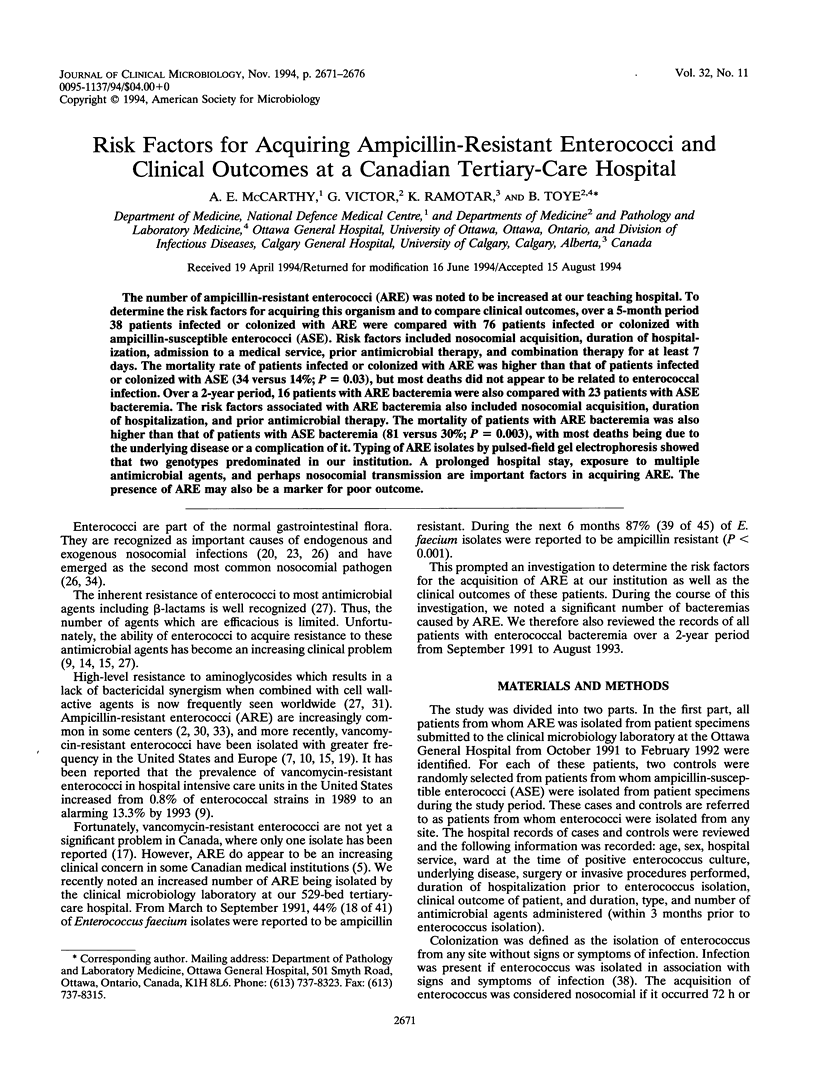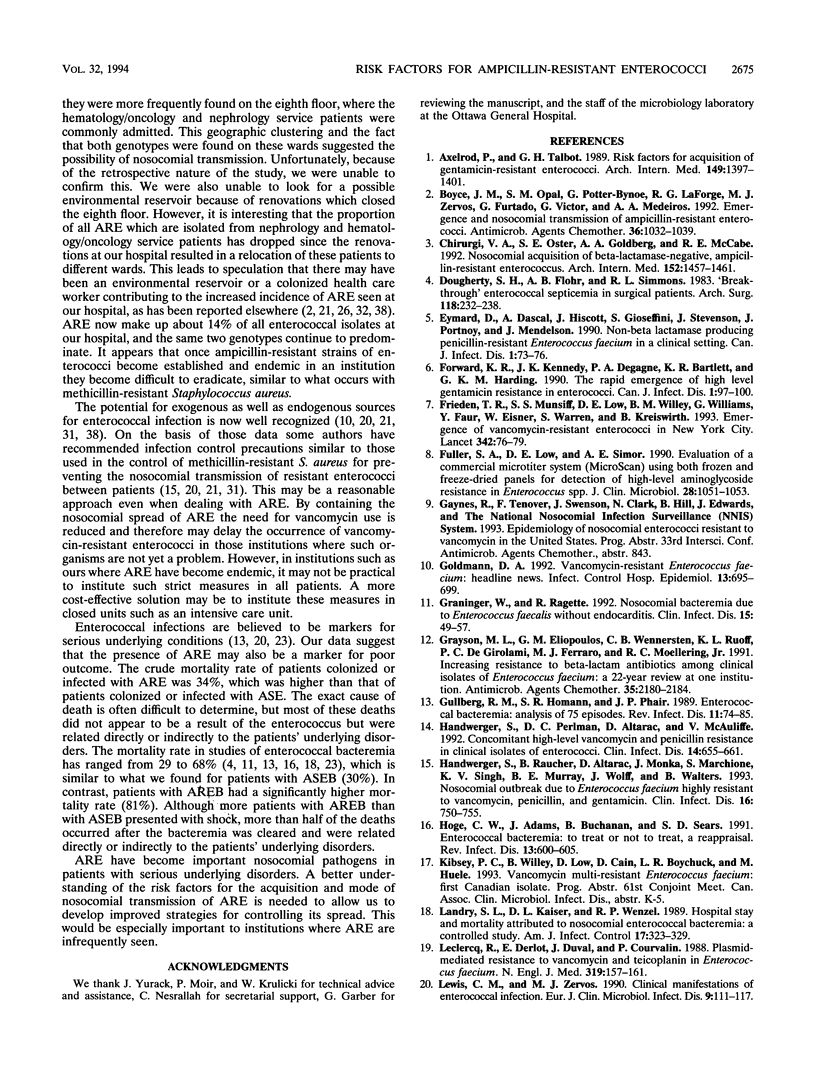Abstract
The number of ampicillin-resistant enterococci (ARE) was noted to be increased at our teaching hospital. To determine the risk factors for acquiring this organism and to compare clinical outcomes, over a 5-month period 38 patients infected or colonized with ARE were compared with 76 patients, infected or colonized with ampicillin-susceptible enterococci (ASE). Risk factors included nosocomial acquisition, duration of hospitalization, admission to a medical service, prior antimicrobial therapy, and combination therapy for at least 7 days. The mortality rate of patients infected or colonized with ARE was higher than that of patients infected or colonized with ASE (34 versus 14%; P = 0.03), but most deaths did not appear to be related to enterococcal infection. Over a 2-year period, 16 patients with ARE bacteremia were also compared with 23 patients with ASE bacteremia. The risk factors associated with ARE bacteremia also included nosocomial acquisition, duration of hospitalization, and prior antimicrobial therapy. The mortality of patients with ARE bacteremia was also higher than that of patients with ASE bacteremia (81 versus 30%; P = 0.003), with most deaths being due to the underlying disease or a complication of it. Typing of ARE isolates by pulsed-field gel electrophoresis showed that two genotypes predominated in our institution. A prolonged hospital stay, exposure to multiple antimicrobial agents, and perhaps nosocomial transmission are important factors in acquiring ARE. The presence of ARE may also be a marker for poor outcome.
Full text
PDF





Images in this article
Selected References
These references are in PubMed. This may not be the complete list of references from this article.
- Axelrod P., Talbot G. H. Risk factors for acquisition of gentamicin-resistant enterococci. A multivariate analysis. Arch Intern Med. 1989 Jun;149(6):1397–1401. [PubMed] [Google Scholar]
- Boyce J. M., Opal S. M., Potter-Bynoe G., LaForge R. G., Zervos M. J., Furtado G., Victor G., Medeiros A. A. Emergence and nosocomial transmission of ampicillin-resistant enterococci. Antimicrob Agents Chemother. 1992 May;36(5):1032–1039. doi: 10.1128/aac.36.5.1032. [DOI] [PMC free article] [PubMed] [Google Scholar]
- Chirurgi V. A., Oster S. E., Goldberg A. A., McCabe R. E. Nosocomial acquisition of beta-lactamase--negative, ampicillin-resistant enterococcus. Arch Intern Med. 1992 Jul;152(7):1457–1461. [PubMed] [Google Scholar]
- Dougherty S. H., Flohr A. B., Simmons R. L. 'Breakthrough' enterococcal septicemia in surgical patients. 19 cases and a review of the literature. Arch Surg. 1983 Feb;118(2):232–238. doi: 10.1001/archsurg.1983.01390020076013. [DOI] [PubMed] [Google Scholar]
- Frieden T. R., Munsiff S. S., Low D. E., Willey B. M., Williams G., Faur Y., Eisner W., Warren S., Kreiswirth B. Emergence of vancomycin-resistant enterococci in New York City. Lancet. 1993 Jul 10;342(8863):76–79. doi: 10.1016/0140-6736(93)91285-t. [DOI] [PubMed] [Google Scholar]
- Fuller S. A., Low D. E., Simor A. E. Evaluation of a commercial microtiter system (MicroScan) using both frozen and freeze-dried panels for detection of high-level aminoglycoside resistance in Enterococcus spp. J Clin Microbiol. 1990 May;28(5):1051–1053. doi: 10.1128/jcm.28.5.1051-1053.1990. [DOI] [PMC free article] [PubMed] [Google Scholar]
- Goldmann D. A. Vancomycin-resistant enterococcus faecium: headline news. Infect Control Hosp Epidemiol. 1992 Dec;13(12):695–699. doi: 10.1086/648341. [DOI] [PubMed] [Google Scholar]
- Graninger W., Ragette R. Nosocomial bacteremia due to Enterococcus faecalis without endocarditis. Clin Infect Dis. 1992 Jul;15(1):49–57. doi: 10.1093/clinids/15.1.49. [DOI] [PubMed] [Google Scholar]
- Grayson M. L., Eliopoulos G. M., Wennersten C. B., Ruoff K. L., De Girolami P. C., Ferraro M. J., Moellering R. C., Jr Increasing resistance to beta-lactam antibiotics among clinical isolates of Enterococcus faecium: a 22-year review at one institution. Antimicrob Agents Chemother. 1991 Nov;35(11):2180–2184. doi: 10.1128/aac.35.11.2180. [DOI] [PMC free article] [PubMed] [Google Scholar]
- Gullberg R. M., Homann S. R., Phair J. P. Enterococcal bacteremia: analysis of 75 episodes. Rev Infect Dis. 1989 Jan-Feb;11(1):74–85. doi: 10.1093/clinids/11.1.74. [DOI] [PubMed] [Google Scholar]
- Handwerger S., Perlman D. C., Altarac D., McAuliffe V. Concomitant high-level vancomycin and penicillin resistance in clinical isolates of enterococci. Clin Infect Dis. 1992 Mar;14(3):655–661. doi: 10.1093/clinids/14.3.655. [DOI] [PubMed] [Google Scholar]
- Handwerger S., Raucher B., Altarac D., Monka J., Marchione S., Singh K. V., Murray B. E., Wolff J., Walters B. Nosocomial outbreak due to Enterococcus faecium highly resistant to vancomycin, penicillin, and gentamicin. Clin Infect Dis. 1993 Jun;16(6):750–755. doi: 10.1093/clind/16.6.750. [DOI] [PubMed] [Google Scholar]
- Hoge C. W., Adams J., Buchanan B., Sears S. D. Enterococcal bacteremia: to treat or not to treat, a reappraisal. Rev Infect Dis. 1991 Jul-Aug;13(4):600–605. doi: 10.1093/clinids/13.4.600. [DOI] [PubMed] [Google Scholar]
- Landry S. L., Kaiser D. L., Wenzel R. P. Hospital stay and mortality attributed to nosocomial enterococcal bacteremia: a controlled study. Am J Infect Control. 1989 Dec;17(6):323–329. doi: 10.1016/0196-6553(89)90001-1. [DOI] [PubMed] [Google Scholar]
- Leclercq R., Derlot E., Duval J., Courvalin P. Plasmid-mediated resistance to vancomycin and teicoplanin in Enterococcus faecium. N Engl J Med. 1988 Jul 21;319(3):157–161. doi: 10.1056/NEJM198807213190307. [DOI] [PubMed] [Google Scholar]
- Lewis C. M., Zervos M. J. Clinical manifestations of enterococcal infection. Eur J Clin Microbiol Infect Dis. 1990 Feb;9(2):111–117. doi: 10.1007/BF01963635. [DOI] [PubMed] [Google Scholar]
- Livornese L. L., Jr, Dias S., Samel C., Romanowski B., Taylor S., May P., Pitsakis P., Woods G., Kaye D., Levison M. E. Hospital-acquired infection with vancomycin-resistant Enterococcus faecium transmitted by electronic thermometers. Ann Intern Med. 1992 Jul 15;117(2):112–116. doi: 10.7326/0003-4819-117-2-112. [DOI] [PubMed] [Google Scholar]
- Magnussen C. R., Cave J. Nosocomial enterococcal infections: association with use of third-generation cephalosporin antibiotics. Am J Infect Control. 1988 Dec;16(6):241–245. doi: 10.1016/s0196-6553(88)80002-6. [DOI] [PubMed] [Google Scholar]
- Maki D. G., Agger W. A. Enterococcal bacteremia: clinical features, the risk of endocarditis, and management. Medicine (Baltimore) 1988 Jul;67(4):248–269. [PubMed] [Google Scholar]
- Miranda A. G., Singh K. V., Murray B. E. DNA fingerprinting of Enterococcus faecium by pulsed-field gel electrophoresis may be a useful epidemiologic tool. J Clin Microbiol. 1991 Dec;29(12):2752–2757. doi: 10.1128/jcm.29.12.2752-2757.1991. [DOI] [PMC free article] [PubMed] [Google Scholar]
- Moellering R. C., Jr Emergence of Enterococcus as a significant pathogen. Clin Infect Dis. 1992 Jun;14(6):1173–1176. doi: 10.1093/clinids/14.6.1173. [DOI] [PubMed] [Google Scholar]
- Moellering R. C., Jr Enterococcal infections in patients treated with moxalactam. Rev Infect Dis. 1982 Nov-Dec;4 (Suppl):S708–S711. doi: 10.1093/clinids/4.supplement_3.s708. [DOI] [PubMed] [Google Scholar]
- Murray B. E., Singh K. V., Heath J. D., Sharma B. R., Weinstock G. M. Comparison of genomic DNAs of different enterococcal isolates using restriction endonucleases with infrequent recognition sites. J Clin Microbiol. 1990 Sep;28(9):2059–2063. doi: 10.1128/jcm.28.9.2059-2063.1990. [DOI] [PMC free article] [PubMed] [Google Scholar]
- Murray B. E. The life and times of the Enterococcus. Clin Microbiol Rev. 1990 Jan;3(1):46–65. doi: 10.1128/cmr.3.1.46. [DOI] [PMC free article] [PubMed] [Google Scholar]
- Oster S. E., Chirurgi V. A., Goldberg A. A., Aiken S., McCabe R. E. Ampicillin-resistant enterococcal species in an acute-care hospital. Antimicrob Agents Chemother. 1990 Sep;34(9):1821–1823. doi: 10.1128/aac.34.9.1821. [DOI] [PMC free article] [PubMed] [Google Scholar]
- Patterson J. E., Zervos M. J. High-level gentamicin resistance in Enterococcus: microbiology, genetic basis, and epidemiology. Rev Infect Dis. 1990 Jul-Aug;12(4):644–652. doi: 10.1093/clinids/12.4.644. [DOI] [PubMed] [Google Scholar]
- Rhinehart E., Smith N. E., Wennersten C., Gorss E., Freeman J., Eliopoulos G. M., Moellering R. C., Jr, Goldmann D. A. Rapid dissemination of beta-lactamase-producing, aminoglycoside-resistant Enterococcus faecalis among patients and staff on an infant-toddler surgical ward. N Engl J Med. 1990 Dec 27;323(26):1814–1818. doi: 10.1056/NEJM199012273232606. [DOI] [PubMed] [Google Scholar]
- Sapico F. L., Canawati H. N., Ginunas V. J., Gilmore D. S., Montgomerie J. Z., Tuddenham W. J., Facklam R. R. Enterococci highly resistant to penicillin and ampicillin: an emerging clinical problem? J Clin Microbiol. 1989 Sep;27(9):2091–2095. doi: 10.1128/jcm.27.9.2091-2095.1989. [DOI] [PMC free article] [PubMed] [Google Scholar]
- Schaberg D. R., Culver D. H., Gaynes R. P. Major trends in the microbial etiology of nosocomial infection. Am J Med. 1991 Sep 16;91(3B):72S–75S. doi: 10.1016/0002-9343(91)90346-y. [DOI] [PubMed] [Google Scholar]
- Toala P., McDonald A., Wilcox C., Finland M. Susceptibility of group D streptococcus (enterococcus) to 21 antibiotics in vitro, with special reference to species differences. Am J Med Sci. 1969 Dec;258(6):416–430. doi: 10.1097/00000441-196912000-00006. [DOI] [PubMed] [Google Scholar]
- Tritz D. M., Iwen P. C., Woods G. L. Evaluation of MicroScan for identification of Enterococcus species. J Clin Microbiol. 1990 Jun;28(6):1477–1478. doi: 10.1128/jcm.28.6.1477-1478.1990. [DOI] [PMC free article] [PubMed] [Google Scholar]
- Zervos M. J., Kauffman C. A., Therasse P. M., Bergman A. G., Mikesell T. S., Schaberg D. R. Nosocomial infection by gentamicin-resistant Streptococcus faecalis. An epidemiologic study. Ann Intern Med. 1987 May;106(5):687–691. doi: 10.7326/0003-4819-106-5-687. [DOI] [PubMed] [Google Scholar]



